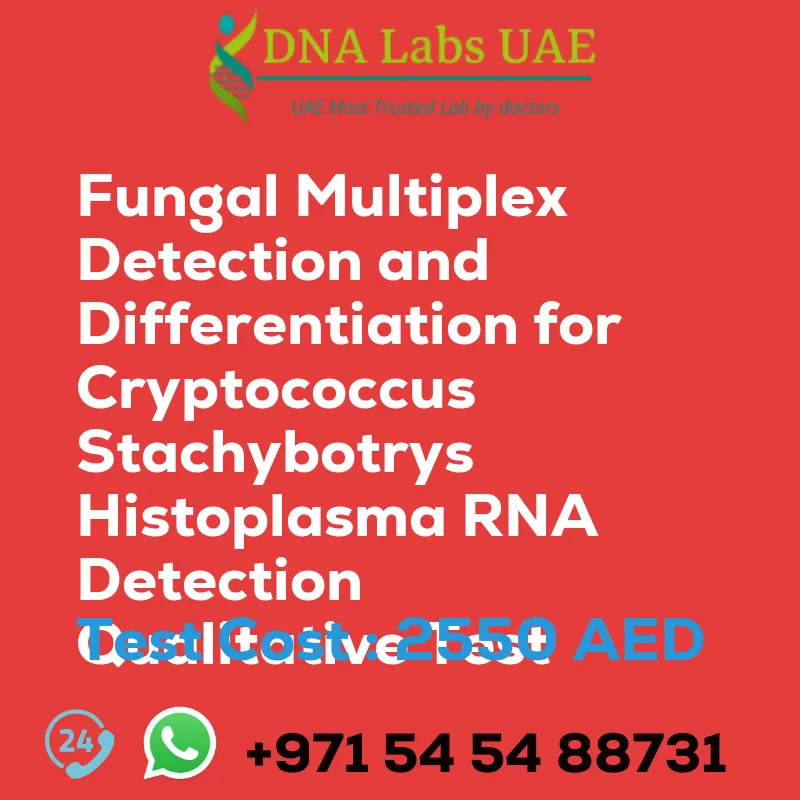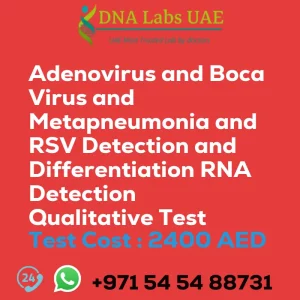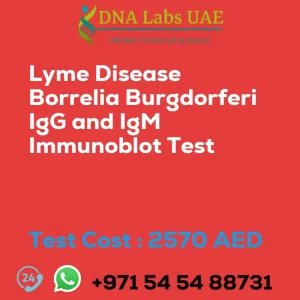Fungal Multiplex Detection and Differentiation for Cryptococcus Stachybotrys Histoplasma RNA Detection Qualitative Test
Test Name: Fungal Multiplex Detection and Differentiation for Cryptococcus Stachybotrys Histoplasma RNA Detection Qualitative Test
Components: Blood, BAL, fresh tissue biopsy specimens, skin biopsy specimen from a patient with disseminated nodular skin lesions, tissue specimens from a variety of body sites (brain, skin and soft tissue, eye, bone, lung, cardiac valve, and bone marrow), peripheral blood specimens, respiratory secretions
Price: 2550.0 AED
Report Delivery: 4th Working Day Email: 48 hours, On phone: 36 hours
Method: Real Time PCR
Test Type: Viral
Doctor: Physician
Test Department: Genetics
Pre Test Information: Need to sign Consent document and bring any clinical history of patient for Fungal Multiplex Detection and Differentiation for Cryptococcus, Stachybotrys, Histoplasma (RNA Detection) Qualitative Test
Test Details
Fungal multiplex detection and differentiation for Cryptococcus, Stachybotrys, and Histoplasma is a qualitative test that aims to identify and differentiate these three fungal pathogens using RNA detection techniques.
Cryptococcus is a yeast-like fungus that can cause severe infections, especially in immunocompromised individuals. Stachybotrys is a mold commonly found in water-damaged buildings and is associated with respiratory issues and other health problems. Histoplasma is a dimorphic fungus that causes histoplasmosis, a respiratory disease primarily affecting the lungs.
The multiplex detection and differentiation test involves the use of specific primers and probes that target unique RNA sequences of each fungal pathogen. These primers and probes are designed to bind specifically to the RNA of Cryptococcus, Stachybotrys, and Histoplasma, allowing for their detection and differentiation.
The test typically involves collecting a sample from the patient, such as blood, sputum, or tissue biopsy, depending on the suspected infection site. The sample is then processed to extract RNA, which is then reverse transcribed into complementary DNA (cDNA). The cDNA is then amplified using polymerase chain reaction (PCR) with the specific primers and probes for each fungal pathogen.
If the target RNA sequences are present in the sample, the PCR amplification will generate a positive signal, indicating the presence of the respective fungal pathogen. By using different fluorescent labels on the probes, the amplified products can be differentiated and identified using a detection system, such as real-time PCR or microarray technology.
The fungal multiplex detection and differentiation test provides a rapid and accurate method for identifying and differentiating Cryptococcus, Stachybotrys, and Histoplasma infections. This information is crucial for appropriate treatment and management of patients with fungal infections, as different pathogens may require different antifungal therapies.
| Test Name | Fungal Multiplex Detection and Differentiation for Cryptococcus Stachybotrys Histoplasma RNA Detection Qualitative Test |
|---|---|
| Components | |
| Price | 2550.0 AED |
| Sample Condition | Blood, BAL,fresh tissue biopsy specimens, skin biopsy specimen from a patient with disseminated nodular skin lesions, tissue specimensfrom a variety of body sites (brain, skin and soft tissue, eye, bone, lung, cardiac valve, and bone marrow), peripheral blood specimens, respiratory secretions |
| Report Delivery | 4th Working Day Email : 48 hours.On phone : 36 hours |
| Method | Real Time PCR |
| Test type | Viral |
| Doctor | Physician |
| Test Department: | Genetics |
| Pre Test Information | Need to sign Consent document and bring any clinical history of patient forFungal Multiplex Detection and Differentiation for Cryptococcus, Stachybotrys, Histoplasma (RNA Detection) QualitativeTest |
| Test Details |
Fungal multiplex detection and differentiation for Cryptococcus, Stachybotrys, and Histoplasma is a qualitative test that aims to identify and differentiate these three fungal pathogens using RNA detection techniques. Cryptococcus is a yeast-like fungus that can cause severe infections, especially in immunocompromised individuals. Stachybotrys is a mold commonly found in water-damaged buildings and is associated with respiratory issues and other health problems. Histoplasma is a dimorphic fungus that causes histoplasmosis, a respiratory disease primarily affecting the lungs. The multiplex detection and differentiation test involves the use of specific primers and probes that target unique RNA sequences of each fungal pathogen. These primers and probes are designed to bind specifically to the RNA of Cryptococcus, Stachybotrys, and Histoplasma, allowing for their detection and differentiation. The test typically involves collecting a sample from the patient, such as blood, sputum, or tissue biopsy, depending on the suspected infection site. The sample is then processed to extract RNA, which is then reverse transcribed into complementary DNA (cDNA). The cDNA is then amplified using polymerase chain reaction (PCR) with the specific primers and probes for each fungal pathogen. If the target RNA sequences are present in the sample, the PCR amplification will generate a positive signal, indicating the presence of the respective fungal pathogen. By using different fluorescent labels on the probes, the amplified products can be differentiated and identified using a detection system, such as real-time PCR or microarray technology. The fungal multiplex detection and differentiation test provides a rapid and accurate method for identifying and differentiating Cryptococcus, Stachybotrys, and Histoplasma infections. This information is crucial for appropriate treatment and management of patients with fungal infections, as different pathogens may require different antifungal therapies. |







